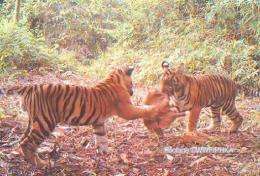Rare wild cats photographed in Indonesia forest

Conservation group WWF called on the Indonesian government Wednesday to protect its forests after photographing some of the world's most endangered exotic wild cats in an area open to logging.
The Sumatran tiger, clouded leopard, marble cat, golden cat and leopard cat were recorded in an unprotected forest corridor, WWF said, between Sumatra's Bukit Tigapuluh National Park and a wildlife sanctuary.
"Four of these species are protected by Indonesian government regulations and are listed as threatened by extinction on the (International Union for Conservation of Nature) Red List," coordinator of the WWF-Indonesia tiger research team Karmila Parakkasi said in a statement.
"These amazing cat photos also remind us of how much we could lose as more of these fragile forests are lost to logging, plantations and illegal encroachment."
Over three months of sampling in the forest corridor this year, WWF's camera traps recorded 404 photos of wild cats, including 226 of Sumatran tigers, 77 of clouded leopards, 70 of golden cats, four of marbled cats and 27 of leopard cats.
The protected Bukit Tigapuluh National Park is among world's most biodiverse tropical forests, with more than 250 other mammal and bird species and 700 plants, according to WWF.
It is designated a global priority tiger conservation area and is one of six landscapes the government of Indonesia pledged to protect at last year's International Tiger Forum in St. Petersburg, Russia.
While the park is protected, WWF said it was at threat by companies surrounding the park, such as Indonesia-based Barito Pacific and Wira Karya Sakti, an exclusive wood supplier to Asia Pulp & Paper (APP).
APP said its timber plantation was beneficial to the park.
"Sustainably managed plantations provide a buffer zone around the park, which is being encroached upon daily. It helps keep out illegal encroachers," APP spokeswoman Aida Greenbury told AFP.
Experts say there are only around 400 Sumatran tigers left in the wild, and although they are critically endangered, they are still poached in Indonesia.
As their habitat is destroyed, wild Sumatran cats have increasingly ventured out of the forest and clashed with people, including a five-year-old girl killed last week.
Indonesia is currently under a two-year deforestation moratorium, during which new licences on primary forest and carbon-rich peatland are banned.
The ban is the centrepiece of a $1 billion environmental conservation partnership with Norway, aimed in part at reducing Indonesia's greenhouse gas emissions by avoiding deforestation of carbon-rich land.
Before the ban, Indonesia was one of the world's fastest deforesters, losing the equivalent of 300 football fields an hour, according to Greenpeace, accounting for around 70 percent of the country's carbon emissions.
(c) 2011 AFP

















